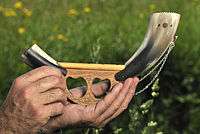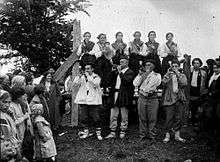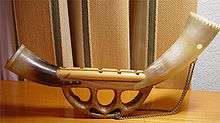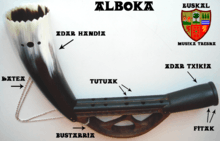Alboka
The Basque alboka (albogue), is a single-reed woodwind instrument consisting of a single reed, two small diameter melody pipes with finger holes and a bell traditionally made from animal horn. Additionally, a reed cap of animal horn is placed around the reed to contain the breath and allow circular breathing for constant play. In basque language alboka player have the name albokari. Alboka is usually used to accompany a tambourine singer. [1]


Although native to the Basque region, similar instruments can be found around Spain including Madrid (gaita serrana), Asturias (turullu), and Castile and Andalusia (gaita gastorena), but in those cases they only have a single pipe. The name is derived from the Arabic "al-bûq" (البوق), which means "the trumpet" or "the horn".
Hornpipes are made of a single reed, a small diameter melody pipe with fingerholes, and a bell traditionally made of animal horn. An animal horn reed cap usually encompasses the idioglot reed. These instruments are descended from single-reed idioglot instruments found in Egypt as early as 2700 BCE.[2] During the Old Kingdom in Egypt (2778-2723 BCE), memets were depicted on the reliefs of seven tombs at Saqqarra, six tombs at Giza, and the pyramids of Queen Khentkaus.[3] Horns were later added to the reed pipe to increase resonance. Horn caps were also added around the reed, and the player would blow into the hornpipe to activate the reed instead of holding it in their mouth.[4]
The alboka has two cane pipes, a wood handle, and a horn at each end. It may be descended from the Moroccan double hornpipe, which has two cane pipes, each fitted with a cow horn.[2] The alboka was established in Spain by the end of the 13th-century. Representations of it can be found in the “Poema de Alexandre” and surviving medieval sculptural church decorations.
Notable Alboka players are Ibon Koteron and Alan Griffin. It is also being integrated into modern bands, such as Kalakan. [5]
Gallery
 An alboka on a table.
An alboka on a table. A diagram of an alboka in the Basque language.
A diagram of an alboka in the Basque language. A medieval painting of two alboka players.
A medieval painting of two alboka players. An alboka standing upright.
An alboka standing upright.
See also
- Basque music
- Ibon Koteron
- Albogue
- Hornpipe (musical instrument)
- Erkencho
Bibliography
- Barrenchea, José Mariano y Riezu, P. Jorge de, "Alboka. Entorno folklórico" Archivo Padre Donostia. Lecaroz (Navarra), 1976.
Discography
- Alboka (musical group) Lorius
- Bidaia Oihan
- Kepa Junkera & Ibon Koteron Leonen Orroak
External links
- Alboka's Day 2007 Alan Griffin plays a new alboka in D
- Alboka (Ibon Koteron) (English, French, and Spanish versions)
- Alboka (musicologie.org) (in French)
- Anotaciones historicas sobre el albogue (Juan Bautista Varela de Vega) (in Spanish)
- La alboka y otros albogues (Luis A. Payno) (in Spanish)
- La alboka y los albokaris (Manu Gojenola Onaindia) (in Spanish)
- Bidaia (website of musical group)
- www.albokerue.com // Video Tutorials to learn alboka (Fede de Dios) (Basque, English and Spanish versions)
- Alboka "ITXE" step by step
- Manufacture of an alboka "ITXE"
References
- "Alboka". www.musicologie.org. Retrieved 2020-04-26.
- Midgley, R., ed. (1976). Musical Instruments of the World. United States: Diagram Visual Information Ltd.
- Rice, A.R. (1992). The Baroque Claringet. New York, NY: Oxford University Press.
- Jenkins, J. & Olsen, P.R. (1976). Music and Musical Instruments of the World of Islam. Kent, UK: Westerham Press Ltd.
- "Alboka information, overview and history". Alboka Lamoille. Retrieved 2020-04-26.
- http://construyetualboka.blogspot.com.es
| Wikimedia Commons has media related to Alboka. |
%2C_Martin_Style_3-17_(1859)_-_C.F._Martin_Guitar_Factory_2012-08-06_-_011.jpg)